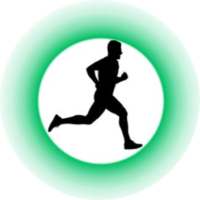Our dependence on cell phones has become second nature in a technologically driven world, completely changing the way we work, communicate, and pass the time. But these devices’ convenience also brings with it a new set of problems, such as the rise of ailments like Cubital Tunnel Syndrome, also referred to as “cell phone elbow.” This article explores the etiology, symptoms, and physical therapy (PT) and occupational therapy (OT) management with Cubital Tunnel Syndrome exercises.
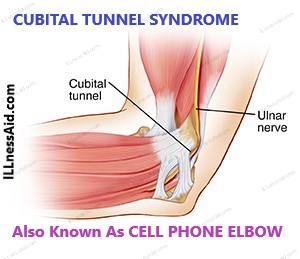
Understanding Cubital Tunnel Syndrome
The ulnar nerve is compressed or irritated as it travels through the cubital tunnel, which is situated on the inside of the elbow, in people with cubital tunnel syndrome. Signal transmission from the brain to the hand and forearm muscles is accomplished by the ulnar nerve. Compression of this nerve can cause a number of symptoms that impair the function of the hand and arm.
Causes and Risk Factors
- Extended Use of Smartphones:
- Relation to Cell Phone Elbow: Prolonged smartphone use that causes habitual elbow bending can put more strain on the ulnar nerve.
- Preventive measures: The ulnar nerve can be less stressed by telling users to swap hands often, take regular rests, and keep their wrists in a neutral position.
- Repeated Elbow Motions:
- Connection to Cubital Tunnel Syndrome: Nerve compression may result from repetitive elbow bending in certain jobs or hobbies.
- Preventive measures: Occupational therapists can advise on ergonomic changes and teach people how to posture their arms correctly for tasks or activities.
- Health Issues:
- Connection to a Mobile Device Elbow: Nerve compression may be exacerbated by diseases such as bone spurs or arthritis.
- Intervention: Exercises to increase joint mobility and decrease inflammation may be the main focus of physical therapists.
Symptoms of Cubital Tunnel Syndrome
Early intervention for Cubital Tunnel Syndrome requires an understanding of its symptoms. People could encounter:
- Mostly in the ring and little fingers, numbness and tingling will feel.
- Weakness: Impairing dexterity and grip.
- Pain: Extending from the hand to the elbow.
- Challenges Arm Straightening: Particularly after extended bending.
Testing for Cubital Tunnel Syndrome
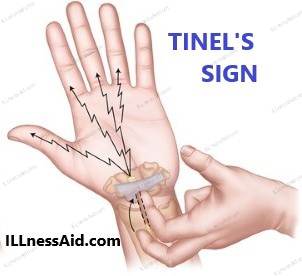
- TINEL’S SIGN
- Procedure: The cubital tube is lightly tapped by a medical professional. Ulnar nerve compression may be present if there is tingling or a shock-like sensation that travels down the forearm and into the hand.
- TEST OF GRIP STRENGTH
- Procedure: A dynamometer can be used to gauge how strong your grip is. Weakness could be a sign of nerve compression-related muscular dysfunction.
- ELBOW FLEXION TEST, OR ULNAR NERVE COMPRESSION TEST
- Procedure: To check for the development of sensations like tingling or numbness, which would indicate ulnar nerve compression, the elbow is kept in flexion for a prolonged amount of time.

These examinations assist medical practitioners in determining the extent of Cubital Tunnel Syndrome and tracking recovery over time.
Treatment For Cell Phone Elbow
Management Of Physical Therapist (PT)
The cornerstone of care for Cubital Tunnel Syndrome is physical therapy. A professional physical therapist customizes interventions to meet each person’s unique needs. These are the main elements of cubital tunnel syndrome physical therapy:
- NERVE GLIDING EXERCISES
- Goal: The goal is to increase the ulnar nerve’s flexibility and range of motion.
- Methods: To promote nerve gliding, use mild exercises including deliberate wrist and finger movements.
- STRENGTHENING EXERCISES
- Goal: Strengthen the muscles surrounding the forearm and elbow.
- Methods: Weights or resistance bands are used in targeted exercises to correct weakness and improve joint stability.
- RANGE OF MOTION EXERCISES
- Goal: Increase elbow joint suppleness and range of motion.
- Methods: Gentle stretches and exercises that improve range of motion without aggravating the condition.
- ERGONOMIC EDUCATION
- Goal: Adjust activities to lessen ulnar nerve stress.
- Methods: Teach people about good ergonomics, particularly when engaging in prolonged elbow flexion exercises.
Management Of Occupational Therapist(OT)
When it comes to assisting people with Cubital Tunnel Syndrome to adjust and maximize their everyday activities, occupational therapy is crucial. OTs give cubital tunnel syndrome exercises according to the patient’s needs. Here’s how occupational therapy can help:
- ACTIVITY MODIFICATION
- Method: Determine which activities make symptoms worse and change them.
- Result: People discover new tools or techniques to complete chores without making their condition worse.
- CUSTOM SPLINTING
- Method: Create and supply specialized splints to keep the elbow and wrist in a neutral position.
- Result: Splints relieve the ulnar nerve’s pressure during particular activities or rest intervals.
- ADAPTIVE EQUIPMENT TRAINING
- Method: Provide instruments or equipment that can be adjusted to help people live independently.
- Result: People learn how to use equipment that puts as little strain on the injured arm as possible.
- SENSATION TESTING
- Method: Evaluate the afflicted fingers’ sensitivity in order to track nerve activity and pinpoint any numbness or tingling.
Cubital Tunnel Syndrome Exercises
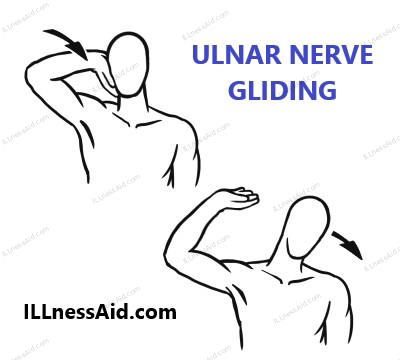
Steps to follow: Place your unaffected hand on your collarbone, hold down your shoulder blade, and sit upright. Raise the afflicted arm shoulder to a 90-degree angle, and bend the elbow to place the hand above the shoulder. The wrist should bent back with neck movement and forth as the little finger’s stress felt.
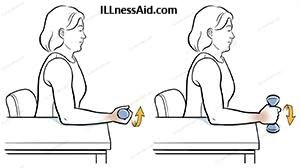
Steps to follow: With your elbow bent at a 90-degree angle, hold a small weight or a soup can in your hand. Swing your forearm in a supinating (palm up) and pronating (palm down) motion. Do two sets of ten to fifteen repetitions in each direction.
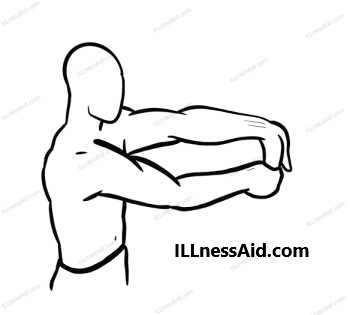
Sets to follow: Straighten out the affected arm. With your other hand, softly push your fingers together for a little stretch as you flex your wrist downward and point your fingers toward the floor. Repeat after holding for 15 to 30 seconds.
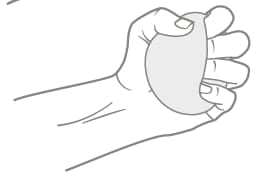
Steps to follow: Squeeze and release the healing putty/ball with the affected hand. As your strength increases, start with a softer putty/ball and work your way up to a stronger putty/ball. Do two sets of ten to fifteen repetitions.

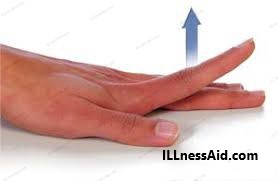
Steps to follow: Lay the afflicted hand flat on a table. One by one, raise each finger by tapping it on the table. Pay attention to deliberate motions. For every finger, tap two sets of ten to fifteen times.
These exercises help to increase overall hand function, strengthen the muscles surrounding the elbow and forearm, and improve flexibility. It’s crucial to carry out these exercises under a doctor’s supervision, particularly if you feel pain or discomfort during or after the workouts.
Preventive Measures for Cell Phone Elbow
It takes both ergonomic awareness and lifestyle changes to prevent mobile phone elbow. The following are some useful advice for individuals:
- Take Breaks: To give your muscles and nerves a chance to relax, schedule breaks in between extended use of your computer or smartphone.
- Stretch Frequently: To keep your fingers, hand, and forearm flexible, do mild stretching exercises.
- Ergonomic Workstations: Make sure your workstations are built ergonomically to minimize strain on the hands and arms.
- Usage: Reduce the amount of time you spend holding the phone to your ear by using a speakerphone or headset.
- Alternate Hands: To spread the strain and avoid overusing one hand when using a smartphone, switch hands.
Conclusion
Cubital Tunnel Syndrome, sometimes known as cell phone elbow, is a contemporary condition that highlights the connection between our digital lives and physical well-being. For those impacted, it is essential to identify the symptoms and comprehend the roles played by occupational therapy and physical therapy in managing them. People can restore function, reduce pain, and carry on comfortably navigating the digital world with the help of focused therapies. The first step to a customized and successful treatment plan is speaking with a healthcare provider if you believe you may have Cubital Tunnel Syndrome symptoms.
Thank u for reading this far, today we talked about cell phone elbow and its management. If you want to know more about cubital tunnel syndrome exercises or a proper rehab plan, you can contact us or get our services.
